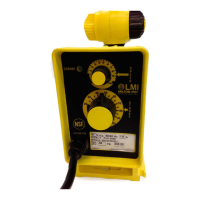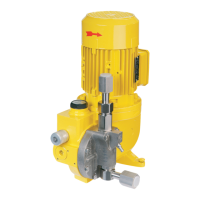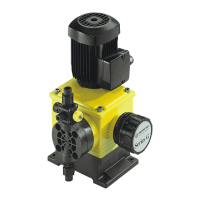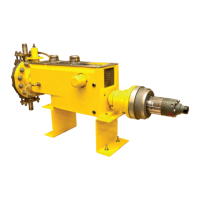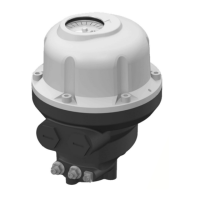9Instruction Manual
SECTION 3 - OPERATION
11. Rotate the motor shaft again so that the pump
is back at TDC (fully extended plunger into the
displacement chamber). Fill this chamber with
ISO-32 oil and check that no air bubbles are
present.
12. Replace the air bleed valve and tighten.
Use a pipe thread sealant to seal the threads.
Be very careful not to get any sealant into the
displacement chamber air bleed port. Place the
end of the tubing into the compression tting
and tighten the lock nut to secure the tubing.
13. On multiplex units, repeat these two steps for
each pump to insure proper hydraulic ll in
each displacement chamber.
14. Recheck the oil level in the catchall reservoir
and install the cover, screws and lock washers.
The gaskets have an adhesive backing that
should be removed and the gaskets should
be rmly attached to the covers using this
adhesive.
15. Make sure that all oil ll caps are securely
tightened to prevent oil leakage.
ALWAYS WEAR THE PROPER
PROTECTIVE GEAR WHEN
WORKING ON THE PUMP LIQUID END.
16. Connect suction and discharge piping
manifolds. Use the proper gaskets and tighten
each ange per specication. Check that all
connections are tight including the check
valves, anges, air bleed valves and the motor
mount bolts.
17. Make sure the process bleeder barb, if so
equipped, is tight. It is located on the front
face of the pump directly under the discharge
check valve. This tting is used to purge any
air that is trapped in the process liquid end.
If this tting is loose when you ll the pump, a
stream of process uid will come out and create
a hazardous condition.
18. It is advisable to test the pump for proper
operation by testing it with water before you
use a process uid. Now ll the process liquid
ends with process uid.
TAKE ADDITIONAL SAFETY
MEASURES APPROPRIATE TO
THE LIQUID BEING PUMPED. BE EXTREMELY CAREFUL IN
THE PRESENCE OF HAZARDOUS SUB-STANCES
(CORROSIVES, TOXINS, SOLVENTS, ACIDS, CAUSTICS, AND
FLAMMABLES).
19. Loosen each process bleeder barb, if so
equipped, on each pump to bleed any air from
the liquid end. Connect a hose to this barb and
use caution if you are pumping a hazardous
chemical. After all process liquid ends have
been purged of air, you can tighten all bleeder
barbs to prevent leakage.
20. Now the motor can be started if and only if all
steps have been followed.
A. For constant speed motors, adjust the stroke
adjustment mechanism so that the indication
needle reads 25-30%. Gradually increase
the capacity adjustment mechanism and
increase back-pressure to insure that the
pump has time to purge all air from the
system.
B. For a variable speed drive, the motor
should be run at a very slow speed between
75-100 revolutions per minute, and the pump
should have minimal process back pressure
for initial start-up. Gradually increase the
motor speed and increase back-pressure
to insure that the pump time to purge all air
from the system.
NOTE:
This concludes the start-up procedure. Please
follow these steps to insure start-up success
and reduce any risk of damage to the pump.

